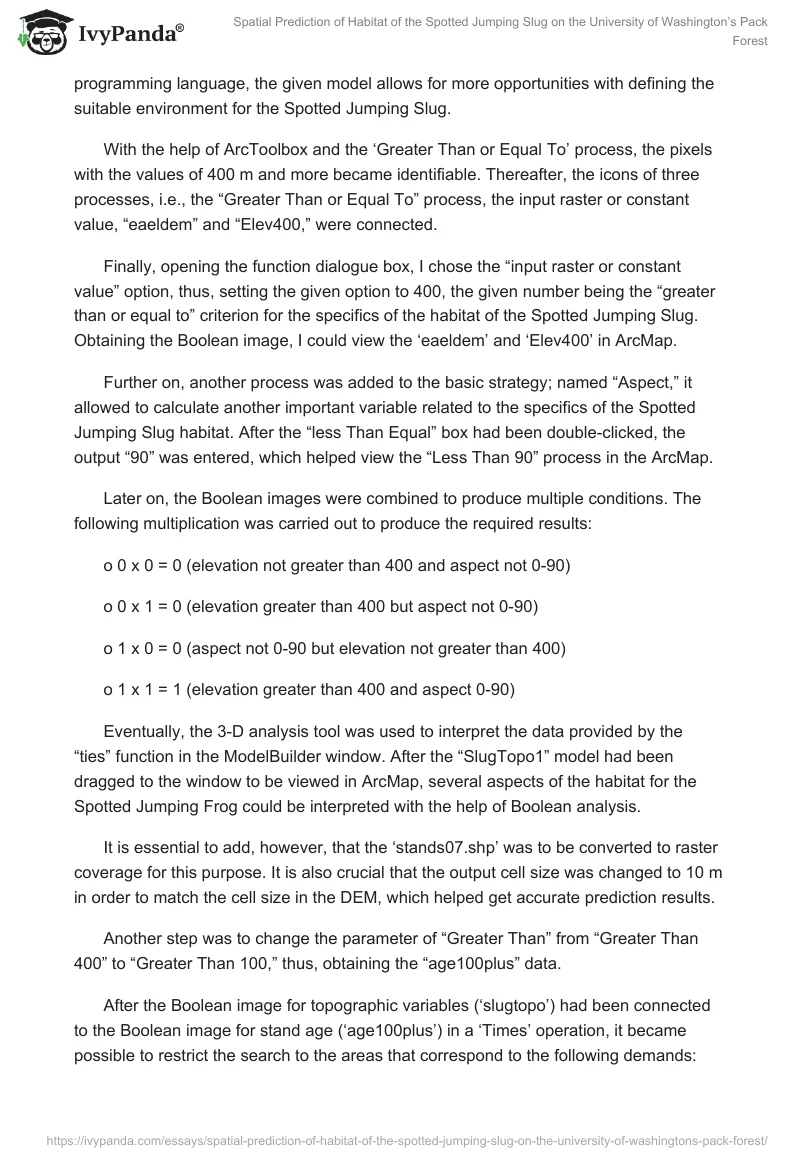Tracking the occurrence of endangered species is extremely important to keep their population stable and prevent these species from extinction. An important tool used to define the specific occurrences of a certain species, spatial prediction can help locate the natural habitat of the Spotted Jumping Slug (Slimus swansonii) and, therefore, help the given species become numerous again.
With the help of the given analysis, one can possibly distill the strategy to restore the population of the Slimus swansonii and, thus, help the Spotted Jumping Slug survive.
According to the existing records concerning the Spotted Jumping Slug, the following characterizes the given species habitat:
- Forests of 100 and more years old;
- Areas above 400 m of elevation;
- Northeast-facing (0–90º aspect) slopes.
Speaking of the obtained data, it is necessary to mention that the “eaeldem” data set was the Digital Elevation Model of the Eatonville-Elbe quadrangles of raster structure, with 10 m pixel resolution, meters being used as key units. Another data set, “stands07.shp” provided the information concerning the coverage of the forest stand attributes at the University of Washington’s Pack Forest and represented a vector shapefile.
The model was created with the help of the ArcCatalog program and named “Slug.” Further on, the model was opened in a ModelBuilder window. Thereafter, 3 files were added using ‘eaeldem’ elevation raster, and ‘stream07.shp’ and ‘stands07.shp’ for later use. These files are represented as three “boxes,” though, technically, they are ellipses.
It is important that the boxes mentioned above can be shaped and modified, thus, allowing for more flexibility. Called a graphical modeling environment or visual programming language, the given model allows for more opportunities with defining the suitable environment for the Spotted Jumping Slug.
With the help of ArcToolbox and the ‘Greater Than or Equal To’ process, the pixels with the values of 400 m and more became identifiable. Thereafter, the icons of three processes, i.e., the “Greater Than or Equal To” process, the input raster or constant value, “eaeldem” and “Elev400,” were connected.
Finally, opening the function dialogue box, I chose the “input raster or constant value” option, thus, setting the given option to 400, the given number being the “greater than or equal to” criterion for the specifics of the habitat of the Spotted Jumping Slug. Obtaining the Boolean image, I could view the ‘eaeldem’ and ‘Elev400’ in ArcMap.
Further on, another process was added to the basic strategy; named “Aspect,” it allowed to calculate another important variable related to the specifics of the Spotted Jumping Slug habitat. After the “less Than Equal” box had been double-clicked, the output “90” was entered, which helped view the “Less Than 90” process in the ArcMap.
Later on, the Boolean images were combined to produce multiple conditions. The following multiplication was carried out to produce the required results:
o 0 x 0 = 0 (elevation not greater than 400 and aspect not 0-90)
o 0 x 1 = 0 (elevation greater than 400 but aspect not 0-90)
o 1 x 0 = 0 (aspect not 0-90 but elevation not greater than 400)
o 1 x 1 = 1 (elevation greater than 400 and aspect 0-90)
Eventually, the 3-D analysis tool was used to interpret the data provided by the “ties” function in the ModelBuilder window. After the “SlugTopo1” model had been dragged to the window to be viewed in ArcMap, several aspects of the habitat for the Spotted Jumping Frog could be interpreted with the help of Boolean analysis.
It is essential to add, however, that the ‘stands07.shp’ was to be converted to raster coverage for this purpose. It is also crucial that the output cell size was changed to 10 m in order to match the cell size in the DEM, which helped get accurate prediction results.
Another step was to change the parameter of “Greater Than” from “Greater Than 400” to “Greater Than 100,” thus, obtaining the “age100plus” data.
After the Boolean image for topographic variables (‘slugtopo’) had been connected to the Boolean image for stand age (‘age100plus’) in a ‘Times’ operation, it became possible to restrict the search to the areas that correspond to the following demands:
- are 400 m and more in elevation;
- are situated on a northeast-facing slope;
- are in stands of 100 years or more.
The resulting pictures showed the possible habitats for the Spotted Jumping Slugs; unfortunately, according to the obtained images, very few areas meet the demands completely.
Finally, the fact that Spotted Jumping Slugs inhabit the areas, which are at least 100 m close to a stream. Therefore, the “Euclidean Distance” tool was also required to perform the calculations. As a result, it turned out that only a small northwest area could be suitable for the Spotted Jumping Slug to live in.
Therefore, judging by the results of the area analysis, it can be considered that there are very few areas suiting the Spotted Jumping Slug as the possible habitat, which are mostly located in the northwestern part of the area. Therefore, it is advisable that more areas with the environment that could possibly sit the Spotted Jumping Slug could be created.
According to the results of the research, only the areas that are located on a northeast slope above 400 m in elevation, in strands of 100 and more years old and within 100 m from streams can suit the Spotted Jumping Slug. Once the balance between the elements of the environment is restored, it can be expected that the number of the Spotted Jumping Slug species will increase.


